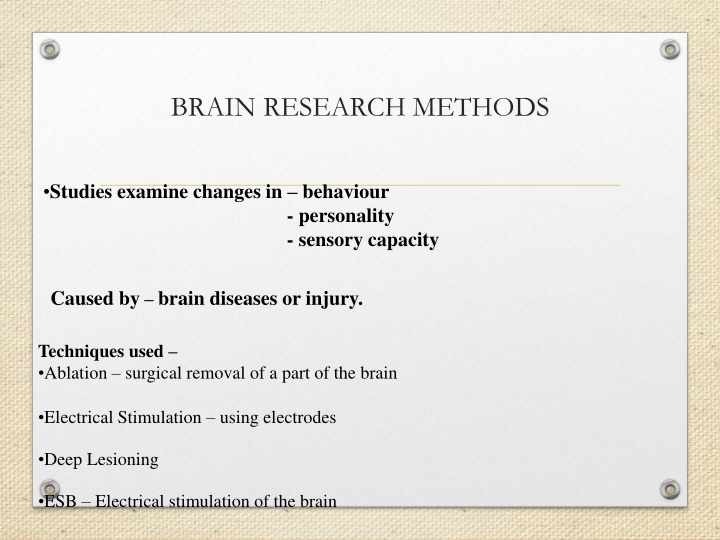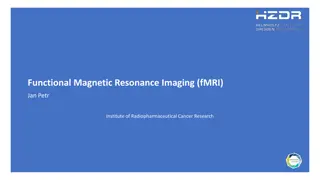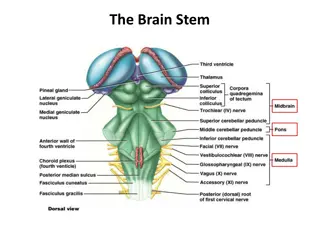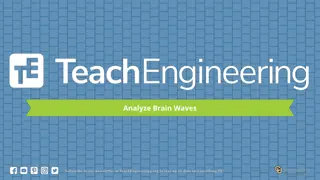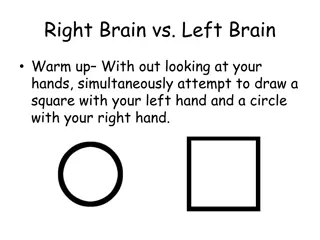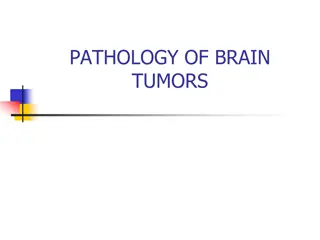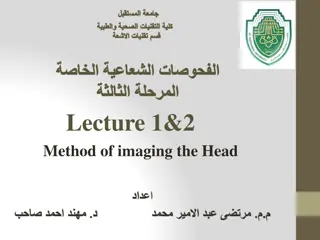Brain Research Methods: Understanding Changes in Brain Function
Studies in brain research methods focus on examining changes in behavior, personality, and sensory capacity caused by brain diseases or injury. Techniques such as ablation, electrical stimulation, deep lesioning, ESB, microelectrodes, and EEG are used to investigate brain functions and responses. Ablation involves surgical removal of brain parts, while electrical stimulation activates brain structures. Deep lesioning destroys brain tissue, and ESB helps create 3D brain maps. EEG records brain activity through electrical impulses, providing valuable insight into conditions like tumors and epilepsy. Each method has its advantages and limitations, contributing to advancing our understanding of the brain's complexities.
Download Presentation

Please find below an Image/Link to download the presentation.
The content on the website is provided AS IS for your information and personal use only. It may not be sold, licensed, or shared on other websites without obtaining consent from the author.If you encounter any issues during the download, it is possible that the publisher has removed the file from their server.
You are allowed to download the files provided on this website for personal or commercial use, subject to the condition that they are used lawfully. All files are the property of their respective owners.
The content on the website is provided AS IS for your information and personal use only. It may not be sold, licensed, or shared on other websites without obtaining consent from the author.
E N D
Presentation Transcript
BRAIN RESEARCH METHODS Studies examine changes in behaviour - personality - sensory capacity Caused by brain diseases or injury. Techniques used Ablation surgical removal of a part of the brain Electrical Stimulation using electrodes Deep Lesioning ESB Electrical stimulation of the brain
1. Ablation Removal of parts of the brain Usually to remove a brain tumour Can determine changes in behaviour or sensory capacity 2. Electrical Stimulation To turn on brain structures The surface of the brain is activated by touching it with a small electrified wire called an electrode. This is done while a patient is conscious as the brain has no pain receptors - Painkillers are local & given for the scalp & skull. 3. Deep Lesioning Used if the structure lies below the surface of the brain A wire electrode (insulated except at tip is inserted into the brain) Electric current used to destroy small areas of brain tissue -
4. Electrical stimulation of the brain - ESB - weaker current is used to stimulate target areas -researchers can make a 3 D brain map which shows - the sensory, motor & emotional responses from the brain. - by stimulating the brain it gives an accurate picture of the brain at work. -This method DOES NOT - damage any part of the brain -remove any part of the brain -cause any change to behaviour
Disadvantages/ limitations of ESB - Is an invasive technique - doesn t give a clear indication of how much of a local area has been stimulated - it is not as precise as lesioning Microelectrodes: Can be used to observe a single neuron, with the tip of the electrode. It is a thin glass tube filled with salty fluid that conducts electricity
5. Electroencephalography - EEG - records what the brain is doing as a whole -measures the waves of electrical activity produced by the brain 1. small disc shaped metal plates are placed on a persons scalp see photo on page 50 2. Electrical impulses from the brain are detected by these electrodes and sent to an EEG. 3. The EEG makes these weak signals (brain waves) bigger and records them on a moving sheet of paper or computer. These patterns can then be used to look at changes during the Recording period or injury or illness.
Electroencephalography - EEG - Brainwave patterns can be used to identify the presence of Tumours, epilepsy or other diseases. -EEG s are used to look at changes in brain activity during Sleep, daydreaming, hypnosis and states of consciousness. Advantages: - non invasive - can be used in many settings Disadvantages: - it records an average measure of the activity of millions of neurons.
Medical Imaging Techniques What are the advantages of using computerised imaging techniques? can look inside an intact brain and see what the person is thinking, or reacting to. non invasive CT scan MRI scan & (fMRI) PET scan
Computerised Tomography (CT scan or CAT scan) - type of x-ray that makes the brain visible (normal x- rays produce a shadowy image of the brain) - the x-ray information is collected by a computer & formed into an image of the brain - dyes can be used to highlight differences in soft tissues USES - shows the location and effects of strokes - used to assess tumours, haemorrhages & abscesses DISADVANTAGES -it cannot be used to provide information on how the brain functions.
Magnetic Resonance Imaging (MRI scan) - uses a strong magnetic field rather than an x ray to produce images of the body s interior. -the body is placed inside a magnetic field. -The information is collected by computer which creates a 3-D picture. - Any 2-D slice of the body can be selected from the MRI data. USES -to detect blow flow to areas of the brain during activities Eg when a patient is completing a task eg a puzzle)
- can assess Strokes, brain & spinal problems weaknesses in blood vessels in the brain Cancerous cells & tumours Lesions caused by epilepsy damage to ligaments and tissues in joints (knees, ankles & wrists). Generally considered safe but long term exposure to high magnetic levels are unknown Functional Magnetic Resonance Imaging (fMRI scan) -works the same as an MRI -BUT makes brain activity visible - allows scientists to pinpoint areas in the brain that control feeling, thoughts & actions -Eg when a person taps their fingers the motor cortex will be highlighted
Functional Magnetic Resonance Imaging (fMRI scan) -works the same as an MRI -BUT makes brain activity visible - allows scientists to pinpoint areas in the brain that controls feeling, thoughts & actions -eg when a person taps their fingers the motor cortex will be highlighted -detects changes in oxygen levels of blood in a functioning brain -it is more sensitive than PET, to rapid changes in neuronal activity so information on function is more precise.
DISADVANTAGES - generally safe -long term effects of exposure to magnetic levels is unknown - some images can be difficult to interpret Positron Emission Tomography (PET scan) -detects positrons (subatomic particles) emitted by weakly radioactive glucose (sugar) as it is used ( uptaken) by the brain. -provides detailed images of structure & function of the brain -Read page 52 Nelson & diagram 2.18
